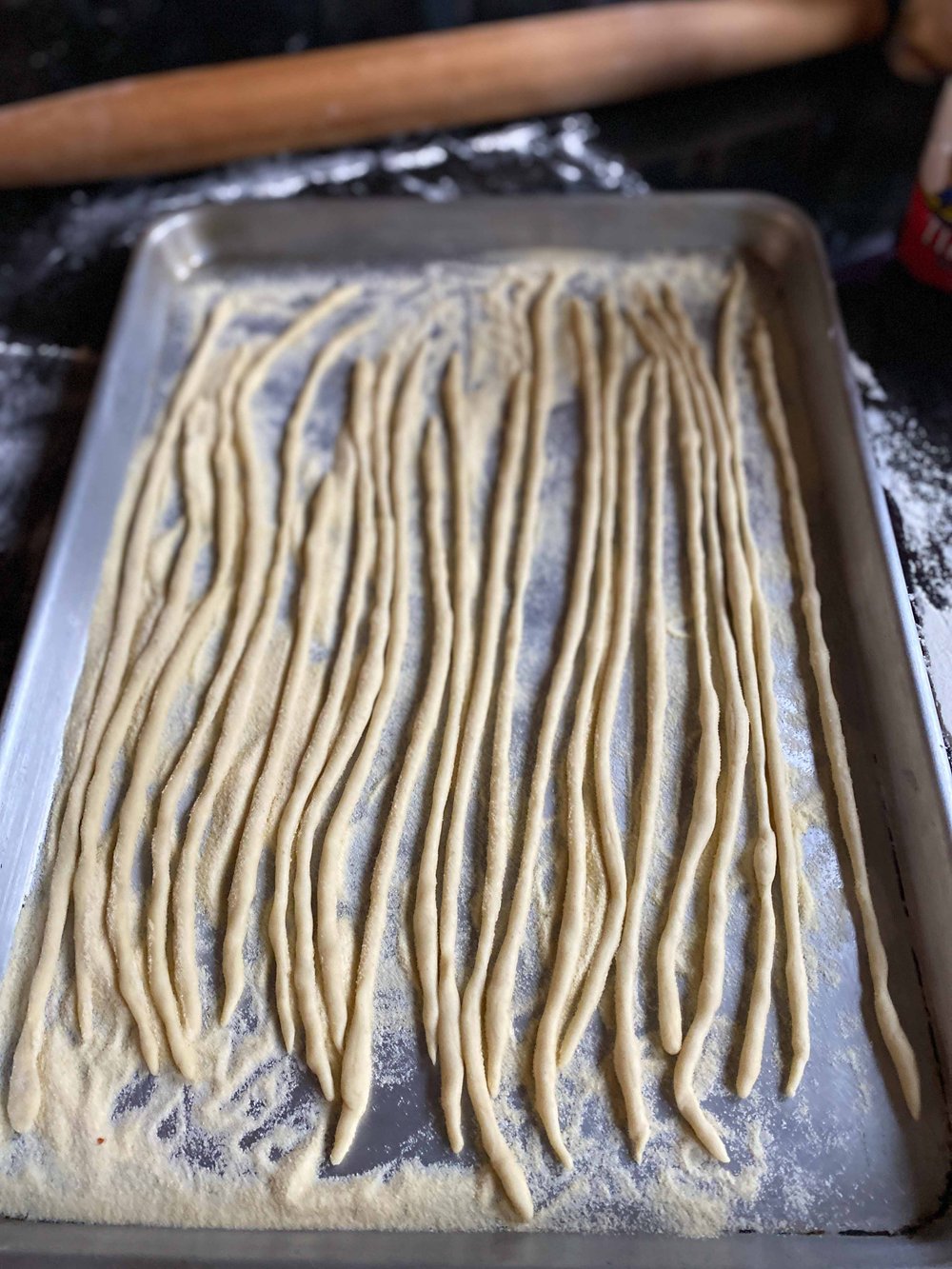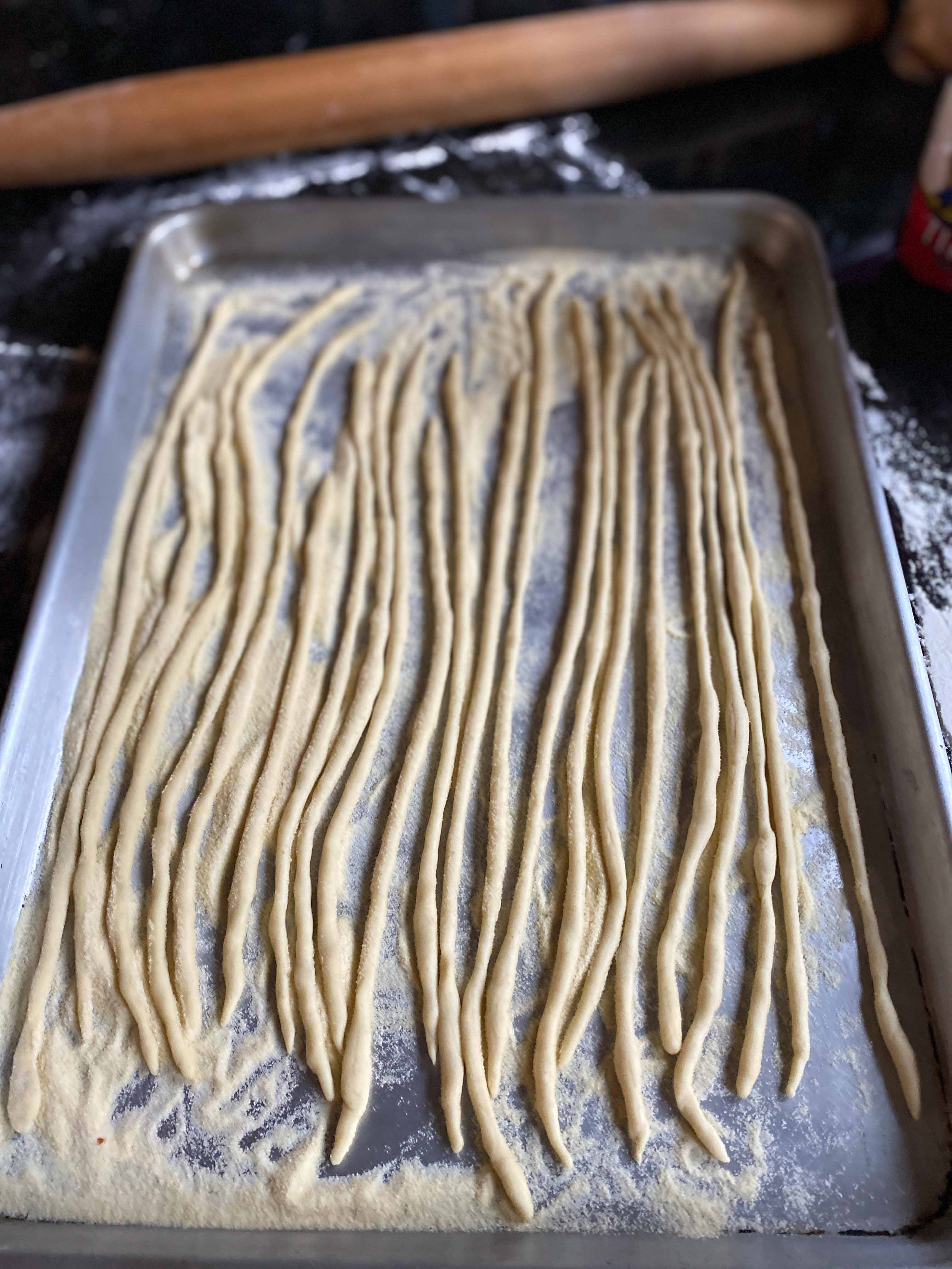Pici (Hand-Rolled Thick Spaghetti)
Adapted from Via Carota: A Celebration of Seasonal Cooking from the Beloved Greenwich Village Restaurant, by Jody Williams and Rita Sodi with Anna Kovel. This recipe for pici — rustic, thick spaghetti with pointy ends — begins by making pasta di semola, an eggless semolina flour pasta dough. The dough can also be used to make trofie, traditionally used with pesto. We love these pici sauced with duck ragù — whether Via Carota’s super-rich one, or the Duck and Porcini Ragù we created a few years back to go with handmade pappardelle. Don’t worry if your pici aren’t perfect; they’re not supposed to be. Bumpy, textured to catch all that ragù and very hand-made-looking is the vibe.
It’s a little messy to pull this simple dough together, but just go with it — it’s actually very forgiving, and it behaves beautifully after its rest.
Note: The original recipe in Via Carota gives a range of time the dough can rest, from one hour to 24 hours. It does not say whether letting it rest overnight would mean that it needs to be wrapped and refrigerated. It also offers instructions for making the dough using a food processor or stand mixer, methods we have not tested. We increased the original recipe by 25%, as the original Via Carota version did not yield enough for the amount of duck ragù used to sauce it.
Makes 17.5 ounces / 500 grams (enough for 4 servings).
Ingredients
1 1/4 cup / 145 grams 00 flour
1 1/4 cup / 175 grams semolina
Large pinch of salt
2 1/2 tablespoons / 37.5 ml extra-virgin olive oil
3/4 cup plus 1 tablespoon / 187.5 ml water
Instructions
1. Put the flour, semolina and salt in a large bowl and whisk it together, then pour it onto a work surface in a mound. Make a deep well in the center of the flour with a fork. Add the olive oil and about 1/3 cup / 80 ml of the water. Use the fork or your fingers to gradually incorporate flour from the inside of the well, mixing from the bottom first in a circular motion. Pour in the remaining water, and gather the mixture into a shaggy dough using a bench scraper and your hands. Pat into a firm dough and scrape the work surface clean.
2. Work the dough vigorously, keading and folding it into a ball. Continue kneading until the dough is smooth and elastic, 10-15 minutes. Slightly flatten the ball of dough and place a bowl over it, or wrap it tightly in plastic wrap. Rest the dough at least 1 hour (at room temp).
3. When you’re ready to roll, dust a sheet pan with semolina. Use a knife or bench scraper to cut the dough ball in half; cover one half with a bowl while you work. On a lightly floured work surface, use a rolling pin to roll the dough until you have a sheet about 1/3 inch / 5 mm thick. Don’t worry about being exact, you’ll be re-shaping them anyway. Use a knife to cut the pasta in short pieces about 1 inch by 2 inches / 2.5 by 5 cm.
4. Roll a piece of pasta between your hands into a short rope, then place it on the board. Place the palms of your hands on top of the pasta rope, and with fingers outstretched, roll the dough back and forth. Work gradually toward the ends to lengthen the dough. Continue rolling and stretching until the rope is thin (the dough will expand when cooked) and about 10 inches / 25 cm long. Don’t try to make them perfect; they will be irregular. Lay the strand out on the sheet pan.
5. Continue with the rest of the dough, sprinkling the pici with semolina to prevent them from sticking together. You can cook them immediately or let them dry until firm.

Pici (Hand-Rolled Thick Spaghetti)
Ingredients
- 1 1/4 cup / 145 grams 00 flour
- 1 1/4 cup / 175 grams semolina
- Large pinch of salt
- 2 1/2 tablespoons / 37.5 ml extra-virgin olive oil
- 3/4 cup plus 1 tablespoon / 187.5 ml water
Instructions
- Put the flour, semolina and salt in a large bowl and whisk it together, then pour it onto a work surface in a mound. Make a deep well in the center of the flour with a fork. Add the olive oil and about 1/3 cup / 80 ml of the water. Use the fork or your fingers to gradually incorporate flour from the inside of the well, mixing from the bottom first in a circular motion. Pour in the remaining water, and gather the mixture into a shaggy dough using a bench scraper and your hands. Pat into a firm dough and scrape the work surface clean.
- Work the dough vigorously, keading and folding it into a ball. Continue kneading until the dough is smooth and elastic, 10-15 minutes. Slightly flatten the ball of dough and place a bowl over it, or wrap it tightly in plastic wrap. Rest the dough at least 1 hour (at room temp).
- When you’re ready to roll, dust a sheet pan with semolina. Use a knife or bench scraper to cut the dough ball in half; cover one half with a bowl while you work. On a lightly floured work surface, use a rolling pin to roll the dough until you have a sheet about 1/3 inch / 5 mm thick. Don’t worry about being exact, you’ll be re-shaping them anyway. Use a knife to cut the pasta in short pieces about 1 inch by 2 inches / 2.5 by 5 cm.
- Roll a piece of pasta between your hands into a short rope, then place it on the board. Place the palms of your hands on top of the pasta rope, and with fingers outstretched, roll the dough back and forth. Work gradually toward the ends to lengthen the dough. Continue rolling and stretching until the rope is thin (the dough will expand when cooked) and about 10 inches / 25 cm long. Don’t try to make them perfect; they will be irregular. Lay the strand out on the sheet pan.
- Continue with the rest of the dough, sprinkling the pici with semolina to prevent them from sticking together. You can cook them immediately or let them dry until firm.




